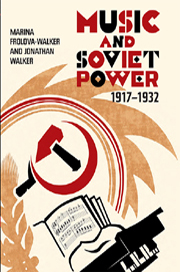Book contents
- Frontmatter
- Contents
- Preface
- Acknowledgements
- Note on transliteration
- Chronology of Political and Musical Events
- October 1917–18: Out of Chaos
- 1919: Depression and Fever
- 1920: Bureaucracy on the Rise
- 1921: Should I stay or should I go?
- 1922: Just Like the Old Days?
- 1923: The Birth of ASM and RAPM
- 1924: ASM in the Ascendant
- 1925: Equilibrium
- 1926: Guests from the West
- 1927: Celebrations
- 1928: At the Crossroads
- 1929: Velikiy perelom – The Great Turning Point
- 1930: RAPM's Glorious Year?
- 1931: RAPM's Fortunes Turning
- 1932: The Rules Change
- Key to Acronyms and Institutional Bodies
- Glossary of Names
- Bibliography
- Index
1928: At the Crossroads
Published online by Cambridge University Press: 05 April 2013
- Frontmatter
- Contents
- Preface
- Acknowledgements
- Note on transliteration
- Chronology of Political and Musical Events
- October 1917–18: Out of Chaos
- 1919: Depression and Fever
- 1920: Bureaucracy on the Rise
- 1921: Should I stay or should I go?
- 1922: Just Like the Old Days?
- 1923: The Birth of ASM and RAPM
- 1924: ASM in the Ascendant
- 1925: Equilibrium
- 1926: Guests from the West
- 1927: Celebrations
- 1928: At the Crossroads
- 1929: Velikiy perelom – The Great Turning Point
- 1930: RAPM's Glorious Year?
- 1931: RAPM's Fortunes Turning
- 1932: The Rules Change
- Key to Acronyms and Institutional Bodies
- Glossary of Names
- Bibliography
- Index
Summary
1928 was a year of great economic and political turbulence. Trotsky's Opposition had already been destroyed and Trotsky himself expelled from the Party, but far from closing down the Party-wide debates the Oppositionists had demanded, these debates were simply shifted to the upper echelons of the Party. Now Stalin, in a striking about-turn, adopted a policy of rapid industrialisation, which had been the main plank of the Opposition (albeit with very different tactics), while Rykov and Bukharin now found themselves increasingly marginalised on the Party's right wing for trying to sustain the same policies Stalin had so recently endorsed. But what might seem arbitrary, or even perverse on Stalin's part, makes more sense when set alongside events. The country was plunged into a severe economic crisis, through bad luck, it would seem, rather than bad policy: the rumours of impending war, although they had little foundation, prompted fearful peasants to hoard grain instead of selling it on the NEP internal market. Bread now disappeared from the shelves of city shops. This happened at the worst possible moment, since Stalin had just resolved that substantial grain (and oil) exports would earn the Soviet Union much of the foreign currency it needed to import industrial machinery. The resulting conflict made the continuation of NEP an impossibility. Stalin now imposed ‘extraordinary measures’ to force the peasants to release their grain stocks.
- Type
- Chapter
- Information
- Music and Soviet Power, 1917–1932 , pp. 197 - 216Publisher: Boydell & BrewerPrint publication year: 2012

